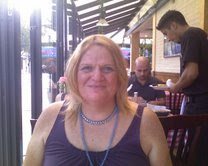On my other blog, I have written several posts about bicycles, and the ways they have been used, in war. It may surprise you to learn that the reason why I am interested in such things--and in military history, with an emphasis on the history--is that I am anti-war. In fact, I believe that the only chance the human race has of surviving-- let alone becoming a better, more enlightened species--is to render war obsolete. Only then will we be truly able to address issues of environmental degradation and economic injustice.
That last sentence also explains why I am anti-war and pro-veteran: To me, few things show how pointless war is than seeing a veteran sleeping under a bridge, highway overpass or train trestle, as I sometimes see on my way to work. It also explains why I see bicycling to work and school, and even for recreation --and not as a self-conscious fashion statement or a callow attempt at irony (Can it really be irony if you're trying to achieve it?)--as an instrument for attaining peace and justice.
So, in that spirit, I am posting this photograph:
Why?, you ask. Well, on this date 70 years ago, a boy named Shin and his best friend, a girl named Kimi, were playing with it when--to paraphrase Albert Camus in The Plague--death rained on them from the clear blue sky.
When Shin's family found him under a house beam, he was too weak to talk. But his hand still held the red grip of that tricycle. And Kimi was nowhere to be found.
Shin would not survive that night. Nor would Kimi, who was found later. Shin's father could not bear to leave him in a lonely graveyard, so he was interred--along with Kimi and the tricycle--in the family's backyard.
In 1985--forty years after the first atomic bomb leveled their home town of Hiroshima--his father decided to move his remains to the family's gravesite. He, with the help of his wife, dug up the backyard burial ground. There they found "the little white bones of Kimi and Shin, hand in hand as we had placed them," according to the father.
Also present was the tricycle, which the father had all but forgotten. Lifting it out of the grave, he said, "This should never happen to children. The world should be a peaceful place where children can play and laugh."
The next day, he would donate the tricycle to the Hiroshima Peace Memorial Museum, where it is exhibited with other artifacts, as well as drawings, photos and stories from survivors of the first atomic bomb, exploded over the city 70 years ago today.
The tricycle inspired a children's book written by survivor Tatsuharu Kodama. Published in 1995, Shin's Tricycle is narrated by Nobuo Tetsunani, Shin's father. It's as painful as it is beautiful. I urge you to read it--and to take a good look at those stark drawings!
That last sentence also explains why I am anti-war and pro-veteran: To me, few things show how pointless war is than seeing a veteran sleeping under a bridge, highway overpass or train trestle, as I sometimes see on my way to work. It also explains why I see bicycling to work and school, and even for recreation --and not as a self-conscious fashion statement or a callow attempt at irony (Can it really be irony if you're trying to achieve it?)--as an instrument for attaining peace and justice.
So, in that spirit, I am posting this photograph:
Why?, you ask. Well, on this date 70 years ago, a boy named Shin and his best friend, a girl named Kimi, were playing with it when--to paraphrase Albert Camus in The Plague--death rained on them from the clear blue sky.
When Shin's family found him under a house beam, he was too weak to talk. But his hand still held the red grip of that tricycle. And Kimi was nowhere to be found.
Shin would not survive that night. Nor would Kimi, who was found later. Shin's father could not bear to leave him in a lonely graveyard, so he was interred--along with Kimi and the tricycle--in the family's backyard.
In 1985--forty years after the first atomic bomb leveled their home town of Hiroshima--his father decided to move his remains to the family's gravesite. He, with the help of his wife, dug up the backyard burial ground. There they found "the little white bones of Kimi and Shin, hand in hand as we had placed them," according to the father.
Also present was the tricycle, which the father had all but forgotten. Lifting it out of the grave, he said, "This should never happen to children. The world should be a peaceful place where children can play and laugh."
The next day, he would donate the tricycle to the Hiroshima Peace Memorial Museum, where it is exhibited with other artifacts, as well as drawings, photos and stories from survivors of the first atomic bomb, exploded over the city 70 years ago today.
The tricycle inspired a children's book written by survivor Tatsuharu Kodama. Published in 1995, Shin's Tricycle is narrated by Nobuo Tetsunani, Shin's father. It's as painful as it is beautiful. I urge you to read it--and to take a good look at those stark drawings!










